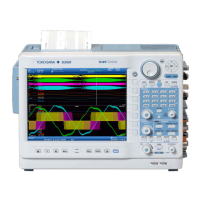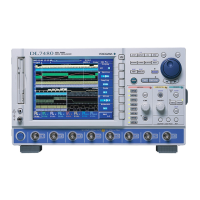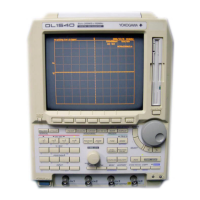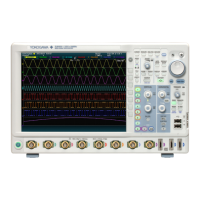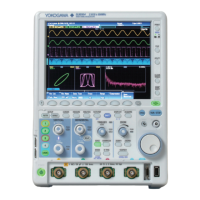2-17
IM DLM6054-01EN
Features
2
1
4
5
6
7
8
9
10
11
12
13
14
15
16
17
18
Index
App
Real-time Sampling Mode (Realtime)
When you change the time axis setting, the sample rate changes. You can sample data at a
maximum sample rate of 2.5 GS/s.
1
(The maximum sample rate is 5 GS/s when Interleave mode is
on.)
2
In this mode, the DL6000/DLM6000 can only display waveforms whose frequency is one-half
the sample rate, in accordance with the sampling theorem.
3
Therefore, this mode is suitable for
observing waveforms whose frequency is lower than one-half the sample rate.
1
On the DL6054, DL6104, DLM6054, and DLM6104 (1.25 GS/s in high resolution mode). On the
DL6154, the sample rate is 5 GS/s (2.5 GS/s in high resolution mode).
2
On the DL6054, DL6104, DLM6054, and DLM6104 (2.5 GS/s in high resolution mode). On the
DL6154, the sample rate is 10 GS/s (5 GS/s in high resolution mode).
3
If the sample rate is comparatively low with respect to the input signal frequency, the harmonics
contained in the signal are lost. When this happens, some of the harmonics will be misread
as low-frequency waves due to the effects described by the Nyquist sampling theorem. This
phenomenon is called aliasing. You can avoid aliasing by acquiring waveforms with the
acquisition mode set to Envelope.
Aliased signal Input signal Sampled points
Interpolation Mode
In Interpolation mode, the DL6000/DLM6000 interpolates the data sampled at 2.5 GS/s up to 1000
times (2000 times in High Resolution mode) using the (sinx)/x function.
*
This essentially increases the sample rate to up to 2.5 TS/s.
Interpolation mode is effective for single-shot signals. If the input signal frequency is high relative to
the sample rate (2.5 GS/s here),
*
aliasing may occur.
* This sample rate applies to the DL6054, DL6104, DLM6054, and DLM6104. On the DL6154, the
sample rate is 5 GS/s.
Repetitive Sampling Mode
In this mode, one waveform is created from several cycles of a repeating signal. This is equivalent
to sampling the signal at a higher sample rate than the actual sample rate. The equivalent sample
rate is 2.5 TS/s maximum.
The DL6000/DLM6000 uses random sampling, which takes ad
vantage of the fact that the time
difference between the trigger point and sampled points is random. The DL6000/DLM6000 realigns
the trigger point each time it acquires a waveform.
This mode is ef
fective for repeating signals, and aliasing rarely occurs.
2.5 Acquisition Conditions

